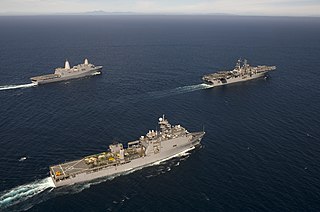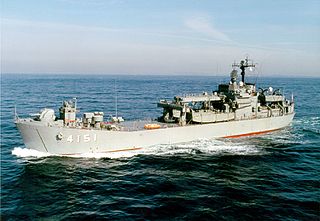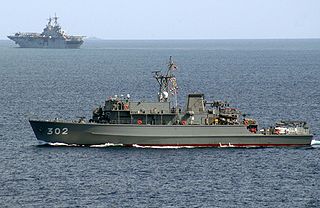
Landing craft are small and medium seagoing watercraft, such as boats and barges, used to convey a landing force from the sea to the shore during an amphibious assault. The term excludes landing ships, which are larger. Production of landing craft peaked during World War II, with a significant number of different designs produced in large quantities by the United Kingdom and United States.

The Landing Craft, Tank (LCT) was an amphibious assault craft for landing tanks on beachheads. They were initially developed by the Royal Navy and later by the United States Navy during World War II in a series of versions. Initially known as the "tank landing craft" (TLC) by the British, they later adopted the U.S. nomenclature "landing craft, tank" (LCT). The United States continued to build LCTs post-war, and used them under different designations in the Korean and Vietnam Wars.

The Landing Craft Air Cushion (LCAC) is a class of air-cushioned landing craft (hovercraft) used by the United States Navy and the Japan Maritime Self-Defense Force (JMSDF). They transport weapons systems, equipment, cargo and personnel from ship to shore and across the beach. It is to be replaced in US service by the Ship-to-Shore Connector (SSC).

A landing ship, tank, (LST) is a ship first developed during World War II (1939–1945) to support amphibious operations by carrying tanks, vehicles, cargo, and landing troops directly onto a low-slope beach with no docks or piers. The shallow draft and bow doors and ramps enabled amphibious assaults on almost any beach.

A Landing Craft Utility (LCU) is a type of boat used by amphibious forces to transport equipment and troops to the shore. They are capable of transporting tracked or wheeled vehicles and troops from amphibious assault ships to beachheads or piers.

The Ōsumi class (おおすみ型輸送艦), is a Japanese tank landing ship. The class is also known as the Oosumi class. While the Japan Maritime Self-Defense Force (JMSDF) describes the Ōsumi class as tank landing ships (LSTs), they lack the bow doors and beaching capability traditionally associated with LSTs. Functionally, their well deck makes the Ōsumi class more like a dock landing ship (LSD).

An amphibious warfare ship is an amphibious vehicle warship employed to land and support ground forces, such as marines, on enemy territory during an amphibious assault.

The Runnymede-class large landing craft are powered watercraft in the United States Army. They replaced older USN-design landing craft, and are a typical Landing Craft Utility design with a bow ramp and large aft superstructure. They transport rolling and tracked vehicles, containers, and outsized and general cargo from ships offshore to shore, as well as to areas that cannot be reached by oceangoing vessels. It can be self-deployed or transported aboard a float-on/float-off vessel. It is classed for coastal service and one-man engine room operations and does not carry a U.S. Coast Guard COI and is classified under 46 CFR subchapter C-uninspected. The vessel's hull is built to and classed to American Bureau of Shipping (ABS) load line rules, although machinery installations generally met ABS machinery rules when built, the vessels systems are not classed by ABS. The vessel can sustain a crew of 2 warrant officers and 11 enlisted personnel for up to 18 days, and 10,000 miles. This class is also equipped with an aft anchor to assist in retracting from the beach. Several are deployed to Europe and aboard Afloat Prepositioning Ships.

The Type 271 landing craft is a family landing craft of the People's Liberation Army Navy (PLAN). Most models in this class are landing craft utility (LCU)s, but the last model has been developed into a Landing ship medium (LSM).

Mk III LCU class vessels were follow on class of Mk II LCU operated by the Indian Navy and were meant to augment the Indian Navy's amphibious capability. The ships were deployed for maritime roles like maritime security, beaching, un-beaching, humanitarian relief operations and evacuation from distant islands, search and rescue operations and peace-keeping missions. The landing craft were meant for use by amphibious forces to transport equipment and troops to the shore. They were capable of transporting tracked or wheeled vehicles and troops from amphibious assault ships to beachheads or piers. The landing craft were carried on board amphibious assault ships to the objective area. Built and delivered between 1986-87 the mission of the LCU was to land/retrieve personnel and equipment during amphibious operations. LCU's help land personnel and equipment after the initial assault waves of an amphibious operation.

Naval Support Activity Danang or NSA Danang was a United States Navy logistics support organization located in Danang, South Vietnam active from October 1965 to April 1972.

JDS Miura (LST-4151) was the lead ship of the Miura-class landing ship tanks of the Japanese Maritime Self-Defense Force. She was commissioned on 29 January 1975.

JDS Ojika (LST-4152) was the second ship of the Miura-class landing ship tanks of the Japanese Maritime Self-Defense Force. She was commissioned on 22 March 1976.

JDS Satsuma (LST-4153) was the third ship of the Miura-class landing ship tanks of the Japanese Maritime Self-Defense Force. She was commissioned on 17 February 1977.

JS Yaeyama (MSO-301) was the lead ship of the Yaeyama-class minesweepers of the Japanese Maritime Self-Defense Force. She was commissioned on 16 March 1993.

JS Tsushima (MSO-302) was the second ship of the Yaeyama-class minesweepers of the Japanese Maritime Self-Defense Force. She was commissioned on 23 March 1993.

JS Hachijō (MSO-303) was the third ship of the Yaeyama-class minesweepers of the Japanese Maritime Self-Defense Force. She was commissioned on 24 March 1994.

The Osumi-class tank landing ship were a class of transport ships operated by the Maritime Self-Defense Force. It was recommissioned with the donation of three LST-542-class tank landing ship from the US Navy. Initially, it was categorized as a amphibious landing ship, but the ship type was changed on 1 April 1971.

OPS-9 is a two-dimensional radar manufactured by Fujitsu. It is installed as an anti-water search radar on the Maritime Self-Defense Force's escort ship. Variations include OPS-9B and OPS-9C.




















